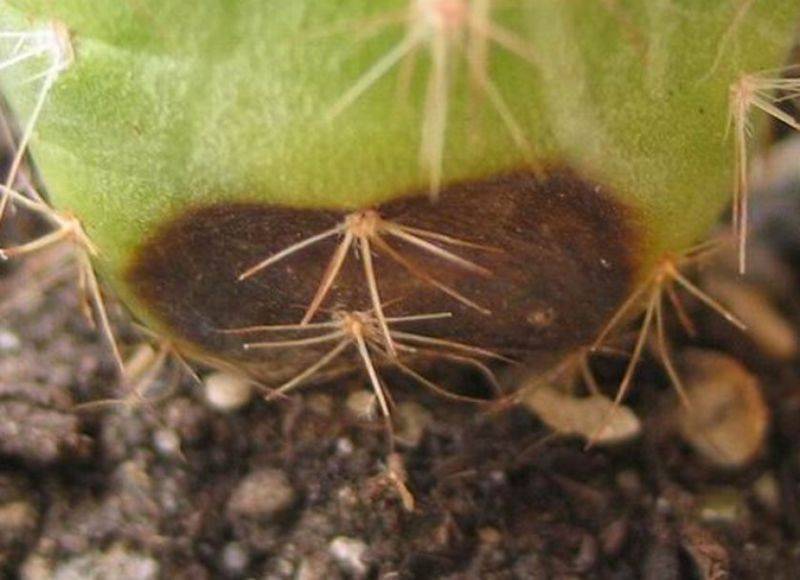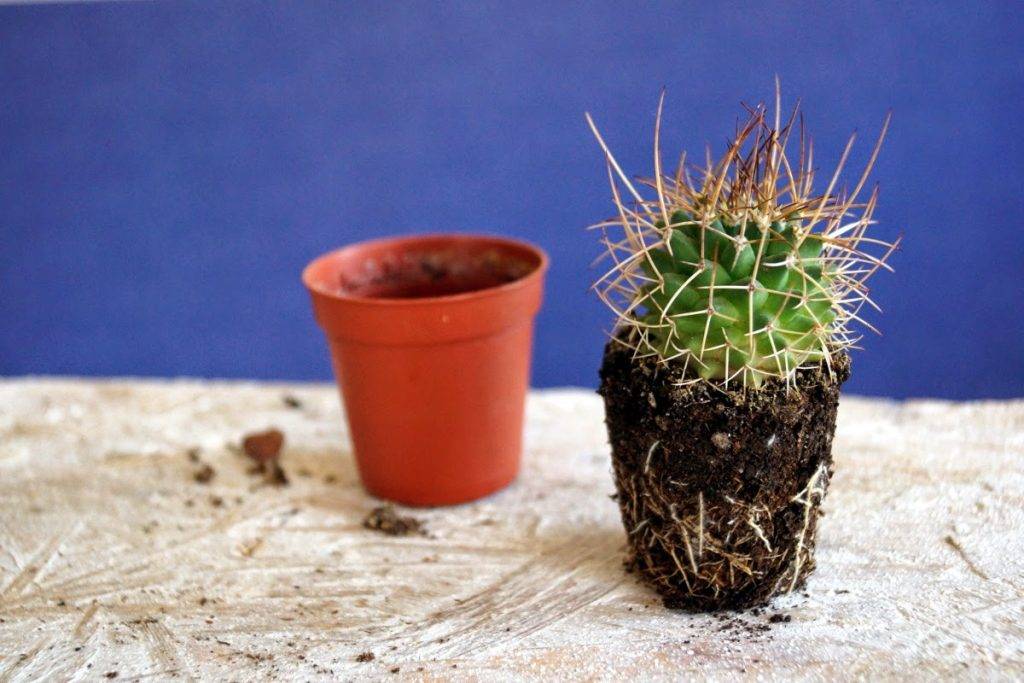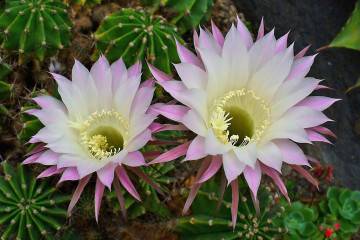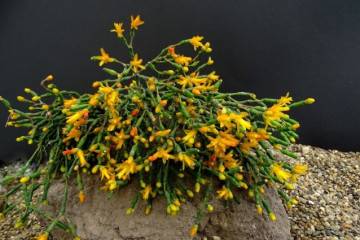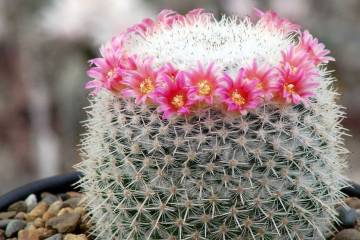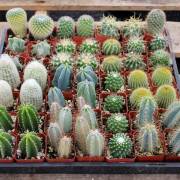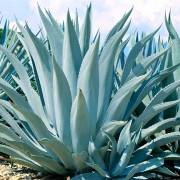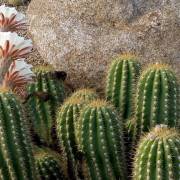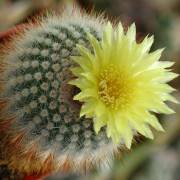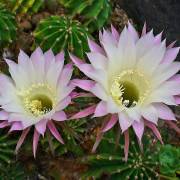Echinocactus Gruzoni - planting and care at home
Content:
Echinocactus Gruzoni is visually similar to a small hedgehog. For decorativeness, undemanding care and relatively slow growth, it is used for growing indoors all over the world.
What does Gruzon's echinocactus look like?
Echinocactus Gruson (Gruzona) is a succulent plant from the genus Echinocactus of the Cactaceae family. In the wild, it lives in Mexico.
In height and in diameter it reaches 100 cm. The stem is thick, barrel-shaped, on which there are large ribs (more than 30 pcs.). They have numerous areoles with amber-colored spines up to 5 cm.
Common varieties
The most popular types of echinocactus:
- red. The stem is standard green. It is covered with bright scarlet thorns. This color is obtained by natural coloring with food coloring or red stamp paint;
- echinocactus Rainbow. Sellers do not limit themselves to coloring the thorns only in red. At Rainbow, they are colored: purple, orange, unnaturally yellow, pink. As they grow, the stems become elongated and elongated.
Echinocactus Texas, horizontal, flat-spiked or wide-spined, Parry, multi-headed, etc. are also in great demand.
Features of caring for a plant at home
The indoor environment is somewhat different from the usual for the plant. However, it quickly adapts to the environment, so Gruzoni's echinocactus does not require special care at home.
Temperature
It tolerates heat well, but can hibernate at 35 ° C and above. The optimum temperature during the growing season is 23-28 ° C. That is, there is no need to take away a special room for the cactus, it will grow well at room temperature.
Lighting
He needs bright lighting, the flower even tolerates direct sunlight.
Watering
In the spring-summer period, echinocactus home care is required in compliance with a certain amount of watering. The flower is watered when the top layer of the substrate dries. Excessive or frequent moisture can cause root rot.
In extreme heat, you need to water once a week, the rest of the time 2 times a month. Optionally wipe with a damp toothbrush to remove dust.
Humidity
The required humidity is 40-50%. This is a suitable indicator for echinocactus in home care.
Priming
An air-permeable soil with a neutral acidity index is required. You can buy it in the store or make it yourself from:
- turf (2 parts);
- leafy ground (1);
- coarse sand (1);
- chipped brick (1/2).
A little wood ash can be added to prevent root infections.
Top dressing
Fertilizers should contain calcium and phosphorus, contain a small amount of nitrogen. For example:
- "Gilea";
- "Master Agro";
- Agricola;
- "Stimulus".
Features of winter care during the rest period
The temperature should be lowered to 10-12 ° C. The critical point is 8 ° C. Echinocactus over 20 years old will tolerate a cold snap to -4 ° C (short-term).
How to water echinocactus in winter? It is necessary to completely stop or produce no more than 1 time per month. No fertilization is necessary.
In winter, the pot with the plant should be placed in the lightest place in the room. In addition, it is possible to organize a daylight hours of 10-12 hours with the help of fluorescent lamps.
When and how it blooms
Only with good care can you see how Gruzoni's echinocactus blooms. This happens around the age of 20.
Types of flowers
Flowers bloom one by one. They are up to 6 cm long. They are located in a wreath at the top of the stem.
Flower shapes
They have a short tomentose flower tube. Corolla bright lemon with multiple and narrow petals.
Flowering period
Echinocactus blooms only in the summer months.
Changes in care during flowering
How to care for echinocactus during flowering? You do not need to make any changes to the standard content. It is only necessary to avoid getting drops on the buds.
How echinocactus Gruzoni reproduces
There are 2 ways to breed.
Germinating seeds
Seed propagation is the preferred method. The seed can be purchased from the store and planted by following the instructions on the package.
Other options
Sometimes echinocactus gives birth to babies on the stem. They can be carefully cut and planted in sand for rooting, covered with plastic or glass.
Transfer
Step by step process:
- Put expanded clay drainage in a new pot (with a layer of 1-2 cm), pour in a little soil mixture.
- Wrap a wire or thick cloth around the stem of the cactus so as not to injure your hands.
- Remove the plant from the old container, place it in a new one so that the roots touch the bottom, but do not bend.
- Fill the voids with earth, tamping it down a little.
- Cover the root collar with sand, sprinkle with a little water.
Possible growing problems and diseases
Like other indoor plants, Echinocactus Gruzoni can infect diseases and pests.
Pests
On echinocactus, scale insects, ticks and mealybugs can start. To avoid the spread of pests to other plants, the affected Gruzoni must be isolated and treated with store-bought preparations.
Diseases
Cactus, echinocactus are resistant to many diseases, but in some cases they can get late blight. In this case, the affected areas should be removed and the plant transplanted into a new pot.
Over-watering and cold air can cause root rot. In this case, diseased roots must be cut off and transplanted into new soil.
Other problems
Due to mistakes in care, the following problems can be observed:
- stem decay occurs due to excess moisture;
- stretching and blanching of the stem, dropping of thorns and buds occur due to lack of lighting;
- drying on one side is possible due to the constant stay of only one side to the heat source (for example, to the battery).
The listed problems are eliminated by adjusting the conditions of detention, so you need to familiarize yourself in advance with how to care for exotic echinocactus.
Signs and superstitions
The plant is believed to soothe overly hot-tempered people. In order for people to enter the apartment with positive energy, the cactus must be placed at the front door or by the window in the living room.
Echinocactus Gruzoni is completely undemanding to the environment. It is enough just to provide warmth for it, periodically water and fertilize. Thanks to its decorative appearance, it will add flavor to any interior, improve the energy in the room.

